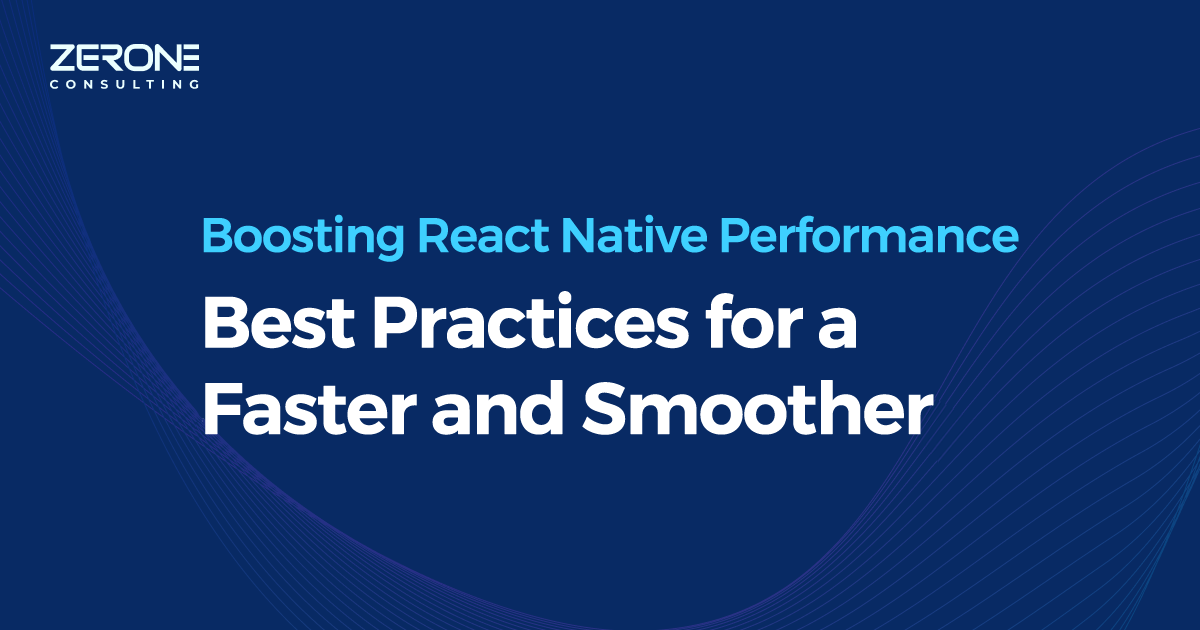16 Proven Ways to Boost React Native Performance
Ever wondered how to make your React Native apps not just functional but lightning fast? This blog shares practical tips to optimize lists, navigation, images, and state management, while also showcasing powerful tools for performance monitoring and efficiency. Dive in and discover how these strategies can transform your app into a more responsive and delightful experience

1. Use FlatList Instead of ListView
One of the biggest performance pitfalls in React Native is using ScrollView to render large lists. ScrollView can be slow, especially as your dataset grows, because it renders all the items at once. Instead, consider switching to FlatList. It’s designed specifically to handle large lists efficiently.
Why FlatList?
- It only renders items that are currently visible on the screen.
- It supports lazy loading and smooth scrolling.
- It uses much less memory, which makes it more efficient.
If you’re still using ListView, it’s definitely time to make the switch for better performance.
2. Upgrade to the Latest Stable React Native Version and External Packages
An effective way to improve your app's performance is to always keep your external libraries and React Native version up to date. There's no denying that React Native is updated continuously and every release more often than not Tend to have some form of bug fixes, performance improvements, along with new features being added.
Keep an eye out for new stable versions of React Native and any external packages that are being used in the application. By upgrading, you'll not only make use of the latest features, but also gain the optimizations and security patches that are included in newer versions.
3. Use Tools Like Flipper and React Native DevTools for Performance Monitoring
Flipper, alongside DevTools for React Native, is a great solution for watching your application’s performance. It tracks key metrics like the CPU, memory, and network usage, which streamlines the process of locating performance barriers.Regular usage of these tools will help any developer locate and address performance issues before it reaches the end-users.
Flipper & React Native DevTools Key Features:
- Performance Monitoring: Track real-time CPU and memory usage.
- Network Monitoring: Identify slow or unnecessary API calls.
- React DevTools Integration: Debug unnecessary re-renders and track state/prop changes.
Regular usage of these tools will help any developer locate and address performance issues before it reaches the end-users.
4. Optimize Images and Assets
Images are one of the heaviest resources in mobile apps, so optimizing them can make a huge difference in performance.
Image Optimization Tips:
- Use the right resolution for different screen densities (1x, 2x, 3x).
- Compress images before adding them to your app (tools like ImageOptim and TinyPNG are great for this).
- Use libraries like react-native-fast-image to improve image caching and loading speeds.
Optimized images lead to faster load times, reduced memory usage, and an overall smoother experience for users.
5. Minimize Re-renders with React.memo
Rendering in React is computationally expensive, so minimizing unnecessary renders can help improve performance. One of the easiest ways to do this is by using React.memo.
What is React.memo?
- It’s a higher-order component that memoizes functional components, meaning they won’t re-render unless their props change.
Here’s a simple example:
const Greeting = memo(function Greeting({ name }) {
return <h1>Hello, {name}!</h1>;
});
Implementing React.memo will guarantee that your components will only re-render when they really need to, thus minimizing needless computation
6. Optimize Navigation
Routing can be a performance killer if there are many screens or if there are complex navigation stacks. React Navigation provides several tools to help with performance.
Performance Tips for Navigation:
- Use lazy loading to load screens only when needed.
- Enable the useNativeDriver for animations to offload animation execution to the native side, which frees up the JavaScript thread.
- Avoid embedding deeply nested navigators, as it could create unnecessary reconciliation which affects performance.
Optimizing structure management may lead to faster transitions and improve performance.
7. Use Hermes for JavaScript Engine
Hermes is an optimized JavaScript engine developed by Facebook specifically for React Native. By using Hermes, you can achieve a reduced startup time, decreased memory usage, and entire size of the app.
Enabling Hermes:
- Set enableHermes: true in your android/app/build.gradle file.
- Rebuild your app.
Enabling Hermes has been shown to dramatically improve startup times and reduce the size of your app, especially for modern React Native apps.
8. Optimize Redux Usage
Redux is a great state management tool, but if not used efficiently, it can lead to unnecessary re-renders and increased memory usage.
Redux Optimization Tips:
- Selective State Updates: Subscribe to only the parts of the store your component needs.
- Use Redux Toolkit: Redux Toolkit simplifies Redux logic and includes performance optimizations out of the box.
By optimizing Redux, you can reduce re-renders and improve app performance.
9. Avoid Unused useState and useEffect Variables
Unused state variables or unnecessary useEffect calls can hurt performance, especially as your app scales. Here are some tips to avoid these pitfalls:
- Remove Unused States: If a state variable is no longer used, remove it to free up memory.
- Use useEffect Carefully: Always specify a precise dependency array to prevent unnecessary calls.
Efficient state and effect management reduces memory consumption and boosts overall performance.
10. Remove Unused Comments, Libraries, and Code
Leaving unused comments, code, or libraries in your project not only adds unnecessary bloat but also makes the app harder to maintain.
Code Cleanup Tips:
- Remove unused imports and libraries.
- Delete commented-out code that no longer serves a purpose.
- Ensure code is well-structured for better readability and scalability.
A cleaner codebase improves performance and makes it easier to manage your app long-term.
11. Use Custom Components Instead of External Packages When Necessary
While third-party libraries can save time, they often come with unnecessary bloat. If a feature is relatively simple, consider building a custom component instead of relying on a package.
Why Use Custom Components?
- Custom components give you complete control over performance.
- They help reduce the overall app size by avoiding unnecessary dependencies.
By building your own components, you can keep your app lightweight and more efficient.
12. Handle Local Storage Efficiently
Efficient management of local storage can greatly improve your app’s performance, especially when dealing with offline data or large datasets.
Local Storage Tips:
- Use encryption and decryption efficiently. If you need to store sensitive data, use libraries like react-native-encrypted-storage.
- Use encryption and decryption efficiently. If you need to store sensitive data, use libraries like react-native-encrypted-storage.
- Cache API responses and data that doesn’t change often to avoid repeated fetching and reduce load times.
Efficient local storage and encryption handling lead to a more responsive app.
13. Use Best Algorithms for Calculations, Search, and Filtering
Using the right algorithms can drastically improve performance, especially when dealing with large datasets or complex operations.
Algorithm Optimization Tips:
- Choose faster sorting algorithms like QuickSort or MergeSort.
- Use binary search or hash tables for quick lookups in large arrays.
- Avoid deep duplicating of the arrays while filtering.
Optimize even your algorithms to ensure the application is responsive while handling even more complicated data.
14. Use Native Swift and Java Code to Enhance Performance
Sometimes the JavaScript engine used by React Native is not enough for performing highly demanding tasks. For computationally costly operations, consider using native Swift for iOS or native Java for Android.
When to Use Native Code:
- For tasks like image processing, cryptography, or background tasks, native code can significantly improve performance.
- Offloading heavy computations to native code helps prevent blocking the JavaScript thread and makes your app more responsive.
Native code allows you to leverage platform-specific optimizations and boost app performance.
15. Use App Size Reduction Techniques
Reducing the size of your app can improve performance by speeding up downloads, reducing memory usage, and decreasing startup times.
Size Reduction Tips:
- Enable Proguard in Android to shrink and obfuscate code.
- Compress images and remove unused assets.
- Use dynamic modules or lazy loading to only load necessary parts of the app.
Smaller app sizes improve installation speeds and reduce memory consumption, making the app more efficient overall.
16. Avoid Unnecessary API Calls, Services, or Renders
Unnecessary API calls or service invocations can slow down your app and degrade performance.
Optimization Tips:
- Cache API responses to avoid making redundant calls.
- Use useMemo or useCallback to memoize functions and avoid recalculating values on each render.
Tracking and minimizing unnecessary operations can drastically reduce network usage and improve responsiveness.
Conclusion
Improving React Native performance requires ongoing effort, but the rewards are well worth it. By following
We can help!



